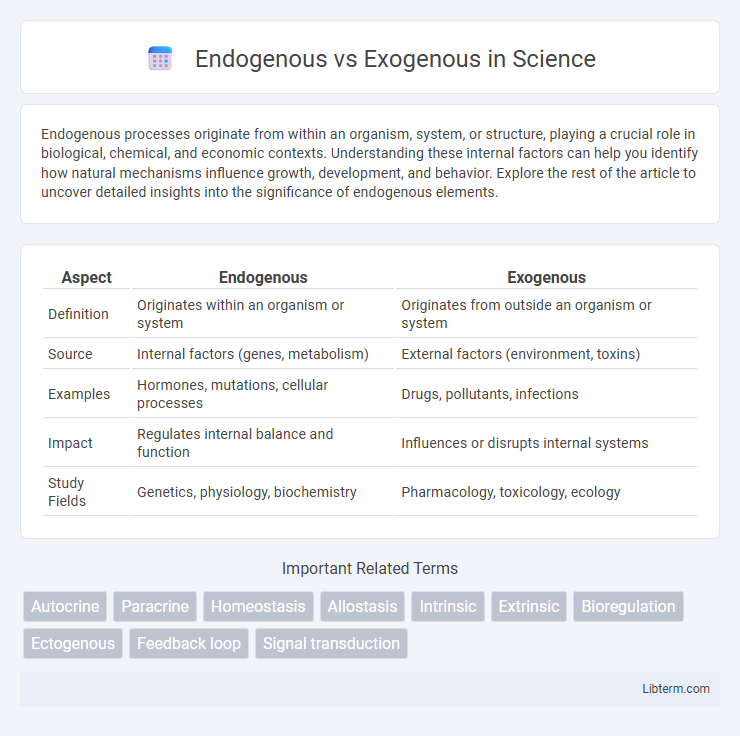Endogenous processes originate from within an organism, system, or structure, playing a crucial role in biological, chemical, and economic contexts. Understanding these internal factors can help you identify how natural mechanisms influence growth, development, and behavior. Explore the rest of the article to uncover detailed insights into the significance of endogenous elements.
Table of Comparison
| Aspect | Endogenous | Exogenous |
|---|---|---|
| Definition | Originates within an organism or system | Originates from outside an organism or system |
| Source | Internal factors (genes, metabolism) | External factors (environment, toxins) |
| Examples | Hormones, mutations, cellular processes | Drugs, pollutants, infections |
| Impact | Regulates internal balance and function | Influences or disrupts internal systems |
| Study Fields | Genetics, physiology, biochemistry | Pharmacology, toxicology, ecology |
Introduction to Endogenous and Exogenous Concepts
Endogenous factors originate within a system, influencing processes from inside, while exogenous factors come from external sources and impact the system externally. In economics, endogenous variables are determined by the model's internal mechanisms, whereas exogenous variables are imposed from outside the model. Understanding the distinction aids in analyzing cause-effect relationships and improving predictive accuracy in various scientific and social contexts.
Defining Endogenous Factors
Endogenous factors are internal elements within a system or organism that influence its behavior or development, such as genes, internal metabolic processes, or organizational policies. These factors originate from inside the system, shaping outcomes without external intervention. Understanding endogenous variables is crucial for analyzing cause-and-effect relationships within complex environments.
Defining Exogenous Factors
Exogenous factors are external influences that affect a system or process from outside its boundaries, such as environmental conditions, economic policies, or technological innovations. These factors are independent of the internal dynamics and cannot be controlled or predicted by the system's internal mechanisms. Understanding exogenous factors is crucial for accurately modeling outcomes in economics, biology, and social sciences, where external shocks or changes can significantly impact behavior and performance.
Key Differences Between Endogenous and Exogenous
Endogenous factors originate from within a system, influencing outcomes based on internal dynamics, while exogenous factors arise externally, impacting systems from outside sources. Key differences include the source of influence--internal for endogenous and external for exogenous--and their role in models, where endogenous variables are explained by the system itself, whereas exogenous variables act as independent inputs. Understanding these distinctions is crucial in fields like economics, biology, and system theory for accurate analysis and forecasting.
Examples of Endogenous Variables
Endogenous variables, such as GDP, inflation rate, and employment levels, are influenced by factors within an economic model, reflecting the system's internal dynamics. For instance, in a macroeconomic model, government spending and consumer consumption are endogenous because they depend on other variables like income and interest rates. These variables contrast with exogenous variables, which originate outside the model and remain unaffected by the system's internal interactions.
Examples of Exogenous Variables
Exogenous variables are factors that originate outside the model and are not influenced by other variables within the system, such as government policy changes, weather conditions, and technological innovations. For example, in an economic growth model, fiscal stimulus imposed by the government acts as an exogenous variable impacting consumption and investment. In environmental studies, natural disasters like hurricanes serve as exogenous shocks affecting ecological systems independently of the model's internal dynamics.
Endogenous vs Exogenous in Economics
Endogenous factors in economics originate within the economic system, influencing variables like investment, consumption, and innovation based on internal mechanisms such as consumer preferences and market dynamics. Exogenous variables, by contrast, come from outside the economic model and include elements like natural disasters, government policy changes, and technological breakthroughs that affect economic outcomes without being influenced by the economy itself. Understanding the distinction between endogenous and exogenous factors is crucial for accurate economic modeling and policy formulation.
Endogenous vs Exogenous in Biology
Endogenous factors in biology originate from within an organism, such as hormones or genetic material, influencing internal physiological and biochemical processes. Exogenous factors come from outside the organism, including environmental influences, pathogens, or toxins that impact health and development. Understanding the interplay between endogenous and exogenous elements is crucial for studying organism behavior, disease mechanisms, and evolutionary adaptations.
Practical Implications of Endogenous and Exogenous Distinctions
Understanding the practical implications of endogenous versus exogenous factors is crucial for effective decision-making in economics and policy analysis. Endogenous variables, influenced within the system, provide insights for predictive modeling and targeted interventions, while exogenous variables, originating outside the model, highlight external shocks requiring adaptive strategies. Distinguishing between these types helps in designing robust economic policies that address internal dynamics or external influences accordingly.
Conclusion: Choosing the Right Perspective
Selecting between endogenous and exogenous perspectives hinges on the specific context and research objectives, with endogenous factors emphasizing internal system dynamics and exogenous factors highlighting external influences. A comprehensive analysis often benefits from integrating both perspectives to capture the full complexity of the subject matter. Prioritizing the appropriate viewpoint enables more accurate modeling, prediction, and decision-making in fields such as economics, biology, and social sciences.
Endogenous Infographic

 libterm.com
libterm.com